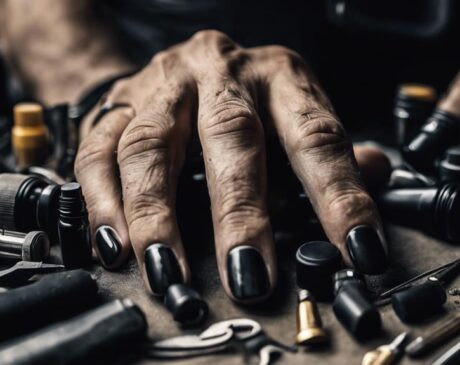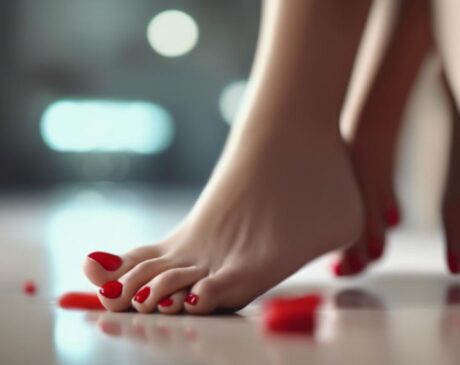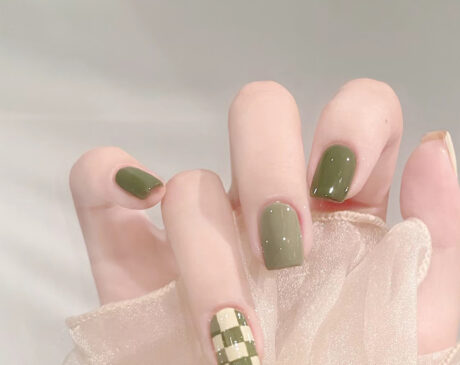Is LED Safer Than UV for Nails?
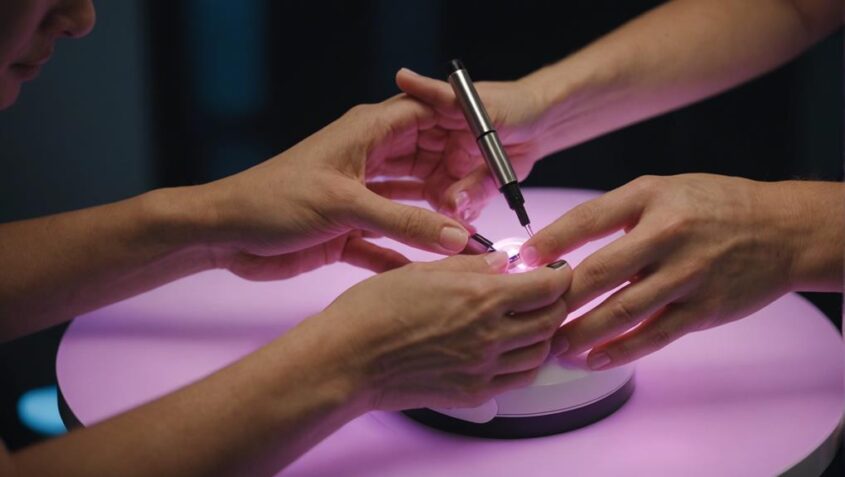
LED nail lamps are considered safer for nails compared to UV lamps. They emit lower levels of UV radiation, reducing the risk of skin damage. LED lights target specific photoinitiators in gel polishes, allowing for faster and more efficient curing. Additionally, LED lamps do not produce heat during the curing process, contributing to healthier nails. The energy-efficient and durable nature of LEDs makes them a preferred choice in salons. Opting for LED technology can provide a safer and more efficient nail curing experience. Learn more about the benefits of LED nail lamps for nail health and UV exposure precautions by exploring the differences in curing processes and potential risks associated with UV exposure.
Key Takeaways
- LED nail lamps emit lower levels of UV radiation, reducing potential harm to nails and skin.
- LED lamps cure nails faster, minimizing overall exposure time to UV radiation.
- LED technology produces less heat during curing compared to UV lamps.
- LED nail lamps are more energy-efficient and durable than UV lamps.
- LED nail lamps are becoming the preferred choice for a safer and efficient nail curing experience.
Understanding LED and UV Lights
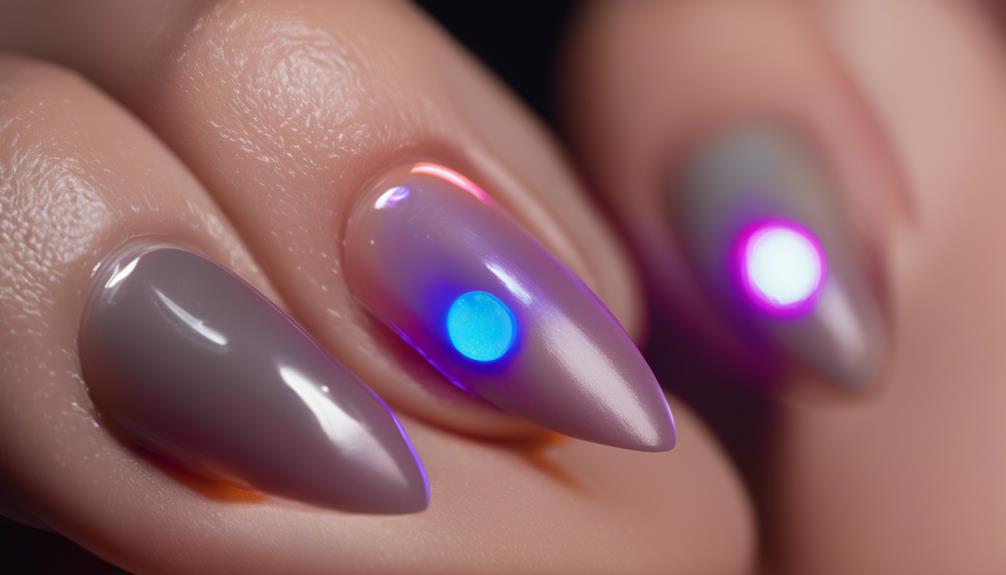
LED and UV lights are commonly used in the beauty industry for curing nail polish. LED, which stands for Light Emitting Diode, emits a narrow spectrum of light that targets specific photoinitiators in gel polishes, causing them to cure or harden quickly. On the other hand, UV lights emit a broader spectrum of light that activates the entire photoinitiator spectrum, resulting in a longer curing time. This key difference in light spectrum is why LED lights are often preferred in salons for their efficiency and faster curing times.
LED lights have gained popularity due to their energy efficiency and durability. They last longer than traditional UV lights and do not require bulb replacements, making them a cost-effective option for salon owners. Additionally, LED lights are considered safer than UV lights because they emit lower levels of UV radiation, reducing the risk of skin damage associated with prolonged exposure during nail curing sessions. As technology continues to advance, LED lights are becoming the go-to choice for nail technicians looking for a safer and more efficient curing method.
Differences in Curing Process
When comparing the curing process between LED and UV lights for nail polish, a notable distinction lies in their respective mechanisms of action. LED lights work by emitting a narrow spectrum of light focused on the specific wavelengths needed to cure the gel polish efficiently. In contrast, UV lights emit a broader spectrum of ultraviolet light that activates photoinitiators in the gel polish to initiate the curing process. This key difference in the type of light emitted affects the speed and efficiency of the curing process. LED lights typically cure gel polish faster than UV lights due to their ability to target the necessary wavelengths more precisely. Additionally, LED lights do not produce heat during the curing process, making them a more comfortable option for users. The targeted nature of LED light also results in less exposure to potentially harmful UV radiation, making it a safer choice for frequent use. Overall, the differences in the curing process highlight the innovative advantages of LED lights over UV lights in nail polish application.
Potential Risks of UV Exposure

Exposure to UV light during nail curing processes has been associated with potential risks that warrant consideration for individuals utilizing this method. Prolonged or repeated exposure to UV radiation can lead to skin damage, including premature aging and an increased risk of skin cancer. The hands are particularly vulnerable as the skin on the back of the hands is thinner and often receives more exposure during nail treatments. Moreover, UV exposure can also weaken the immune system's response in the skin, making it more susceptible to environmental stressors. In addition, there is a risk of UV overexposure leading to the development of dark spots, wrinkles, and other signs of photodamage on the hands. To mitigate these risks, it is essential for individuals undergoing UV nail curing processes to take precautions such as applying broad-spectrum sunscreen, wearing UV-blocking gloves, and limiting the duration of UV exposure. These measures can help protect the skin from potential harm while still enjoying the benefits of UV nail curing techniques.
Impact on Nail Health
Regular exposure to UV light during nail curing processes can have a significant impact on the overall health and integrity of the nails. Prolonged exposure to UV radiation can lead to issues such as nail discoloration, dryness, brittleness, and an increased risk of skin cancer. In comparison, LED nail lamps emit lower levels of UV radiation, reducing the potential harm to the nails and surrounding skin. This makes LED nail curing a safer option for maintaining nail health while achieving a long-lasting manicure.
To highlight the differences between UV and LED nail curing systems, consider the following table:
| Aspect | UV Nail Lamps | LED Nail Lamps |
|---|---|---|
| UV Radiation | Higher levels | Lower levels |
| Curing Time | Longer time needed | Faster curing |
| Energy Efficiency | Less efficient | More efficient |
LED nail lamps not only provide a quicker curing process but also minimize the exposure to harmful UV radiation, promoting healthier nails in the long run.
Which Is Safer for Nails?
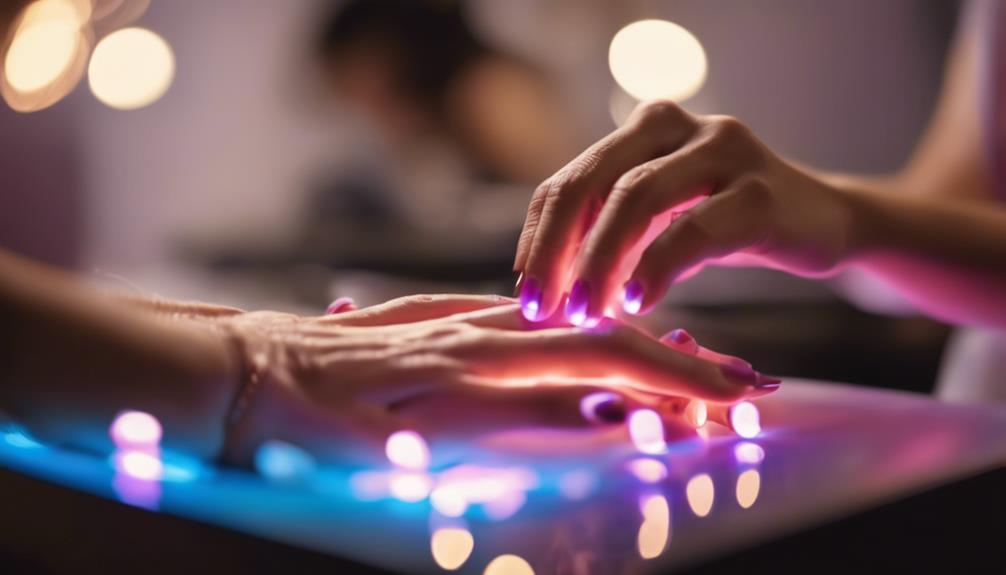
Considering the impact on nail health from exposure to UV light during nail curing processes, the choice between LED and UV nail lamps becomes pivotal in determining which option is safer for maintaining healthy nails. LED nail lamps are generally considered safer than UV lamps due to their lower levels of UV exposure. LED lamps cure nails faster, reducing the overall exposure time to potentially harmful UV radiation. This quick curing process helps prevent any damage that prolonged UV exposure may cause to the skin surrounding the nails.
Additionally, LED lamps produce less heat during the curing process compared to UV lamps, which can further protect the nails and surrounding skin from potential burns or damage. LED technology is also more energy-efficient and longer-lasting than traditional UV lamps, providing a more sustainable and cost-effective option for nail salons and individuals alike. As technology continues to advance, LED nail lamps are becoming the preferred choice for those seeking a safer and more efficient nail curing experience.
Frequently Asked Questions
Can LED or UV Lights Cause Skin Cancer?
LED and UV lights have different wavelengths that impact skin differently. While UV has been linked to skin cancer, LED is considered safer due to lower UV emissions. However, prolonged exposure to any light source should be approached with caution.
Are There Any Long-Term Effects on Nail Strength?
Long-term exposure to LED or UV lights for nail curing may lead to potential weakening of nail strength due to excessive drying. It is essential to follow recommended exposure times and regularly hydrate nails to prevent adverse effects.
How Often Should Nails Be Exposed to These Lights?
Nails should be exposed to LED or UV lights sparingly to prevent potential damage. Research suggests limiting exposure to 2-3 weeks, allowing nails to recover. Prioritize nail health by using protective measures like sunscreen or gloves.
Can LED or UV Lights Damage Nail Beds?
LED and UV lights can potentially damage nail beds if used improperly or for extended periods. It is essential to follow manufacturer guidelines, limit exposure, and prioritize nail health. Consulting a professional for proper nail care is recommended.
Is There a Difference in the Cost of LED Vs. UV Treatments?
LED and UV treatments can vary in cost due to different technologies and brands available. Factors such as energy efficiency, longevity, and curing time may influence the overall expense. It's advisable to research and compare options for optimal results.

